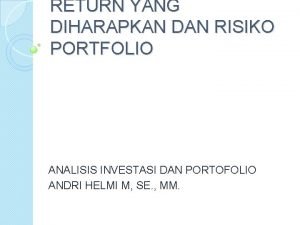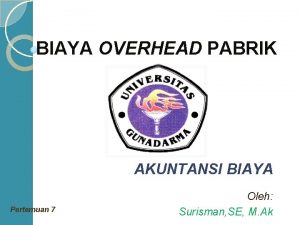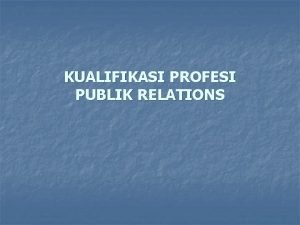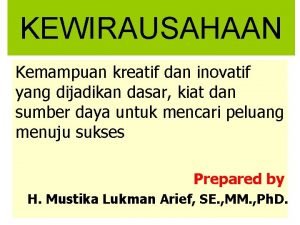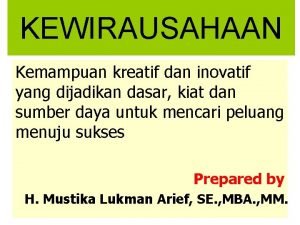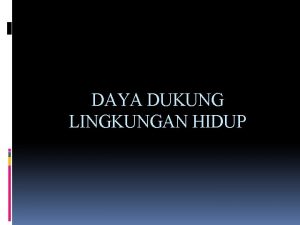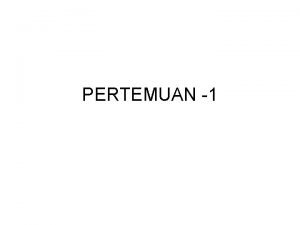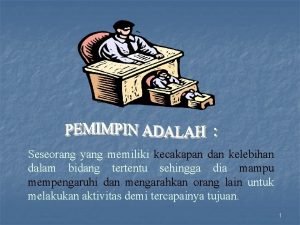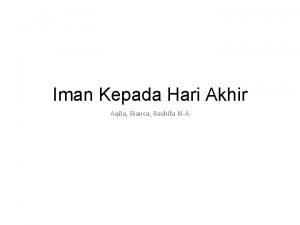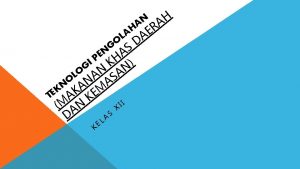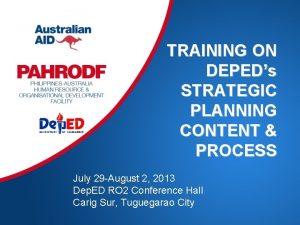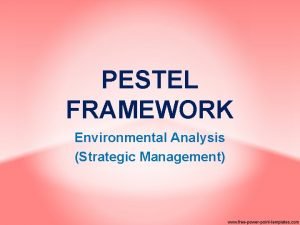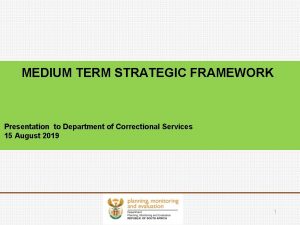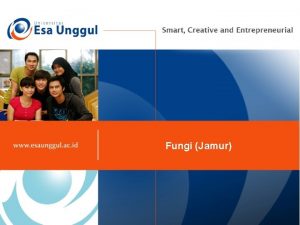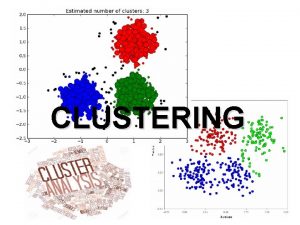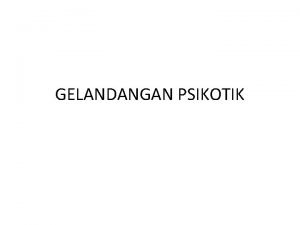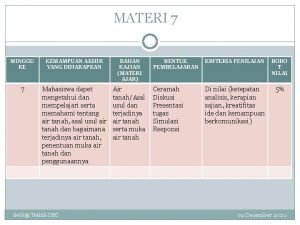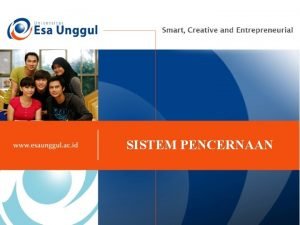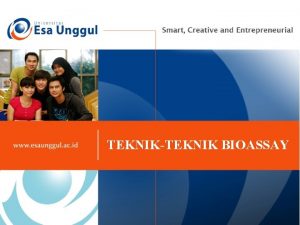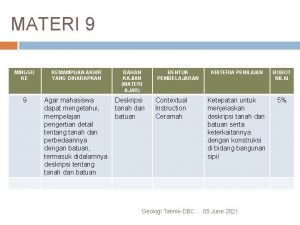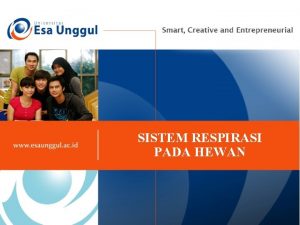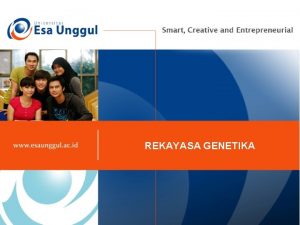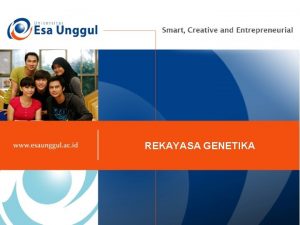Session 4 Strategic Framework Kemampuan Akhir yang Diharapkan


















- Slides: 18

Session 4 Strategic Framework

Kemampuan Akhir yang Diharapkan Setelah mengikuti kuliah ini, mahasiswa diharapkan agar dapat memahami lingkungan bisnis eksternal, memahami keberadaan stakeholder & pressure group, dan menggunakan tools Porter 5 Competitive Forces

Outline External business environment Stakeholders & Pressure Groups Strategic Tools Porter 5 Competitive Forces

External Business Environment • What leads to the success of a business? Does it all come from within the company? No, business environments and how companies react to external factors are key to their success. • An external environment is composed of all the outside factors or influences that impact the operation of business. The business must act or react to keep up its flow of operations.

Types of External Environments • The micro environment consists of the factors that directly impact the operation of a company. There are five factors that affect the micro environment: suppliers, customers, marketing intermediaries, financiers, and public perceptions. • The macro environment consists of general factors that a business typically has no control over. The success of the company depends on its ability to adapt. There are six factors that affect the macro environment, and these include economic, sociocultural, political, legal, technical, and environmental considerations.

Stakeholders & Pressure Groups • Stakeholders are any individual or group that has a personal stake in a business. This can include business owners, investors, shareholders, vendors, suppliers, employees, customers, and people that live in the local community where a business operates. • A group that tries to influence public policy in the interest of a particular cause. The primary goal of a pressure group is to influence some aspect of the way a business operates, including which types of products businesses manufacture.

Evolution of Business Planning (Welleck, dkk. , 1980) Effectiveness of strategic decision making Multi-year budgets Gap analysis Static allocation of resources Annual budgets Functional focus Situation analysis and competitive assessments Evaluation of strategic options Dynamic allocation of resources Well defined strategic framework Strategically focused organization Widespread strategic thinking capability Reinforcing management processes Supportive value system and climate Stage 1 Financial Stage 2 Forecast-based Stage 3 Externally Stage 4 planning (meet budget) planning (predict the future) oriented (think strategically) management (create the future) Strate gic

Framework for Business Planning External Environments Customers Suppliers Shareholders Employees Unions Government Public Stake Holder Economic Technological Political Social Pressure Groups Values Objectives Evaluate feedback Monitor Strategies Ecological Legal Thr. Ceaotms Identify current Identify future edtitors strategies apn. Customers opportunities Analyze internal resources Implement Strategies Evaluate strategies Select Strategies Suppliers Shareholders Employees Unions Public Media Financial Ins.

Input to Business Planning • External environments ‐ sources of important signals to organizations • Pressure groups ‐ demand recognition and rapid management response • Stakeholders ‐ demand fair share of created wealth • Business planning is usually carried out for each strategic business unit – A unit that sells a distinct set of products or services, serve a specific set of customers, and competes with a well‐ defined set of competitors

Definition of Business Strategy • Definition of business strategy: – An integrated set of actions aimed at increasing the long‐ term well‐being and strength of the organization relative to its competitors

Process of Business Planning Establish strategic direction • Define mission and objectives • Assess situation and options • Select options Define strategies Achieve strategies feedback Strategic planning of options selected Implement strategies Strategic thinking and opportunistic decision making

Technique to Develop Business Strategy: Competitive Forces in Industry (Porter, 1980) Threat of new entrants Bargaining power of suppliers Rivalry among existing competitors Threat of substitute product Bargaining power of buyers

Factors A�ecting The Impact of Competitive Forces • New entrants – – Capital requirements Patents and specialists skill required Distribution channels available Achieved/required economies of scale and resultant cost advantages – Number and size of existing rivals and intensity of competition – Differentiation and brand establishment/loyalty – Access to raw materials/critical resources etc. Business strategy: “how to discourage new entrants to come into the business”

Strategic Choices: Factors A�ecting The Impact of Competitive Forces • Substitute products/services – Customer awareness of needs and means of satisfaction – Customer sensitivity to value for money and ability to compare – Existing loyalty of customer—impact of “industry” promotion – Ability to differentiate products etc. Business strategy: “how to create a loyal customers? ”

Strategic Choices: Factors A�ecting The Impact of Competitive Forces • Competitive rivalry will be intensified by: – Market growth slow (or in decline) – Small number of similar sized competitors dominate – High fixed costs and/or high exit barriers for all rivals – Overcapacity and/or capacity increments are large units – Commodity‐like, undifferentiated products. Business strategy: “how to differentiate your products? ”

Strategic Choices: Factors A�ecting The Impact of Competitive Forces • Buyers’ power will be increased by: – Concentrated/few buyers making high volume and/or high value of purchases – Low switching costs across suppliers – Price sensitive and many alternative sources of supply – Weak brand identities, products not differentiated – Buyers capable of backward integration due to low entry cost. Business strategy: “how to make the buyers depend on your business”

Strategic Choices: Factors A�ecting The Impact of Competitive Forces • Suppliers’ power will be increased by: – Few suppliers—high switching costs for rivals and suppliers deal with many small customers – Potential substitute supplier/resources not easily available – Supplied goods make up large part of firm’s costs – Suppliers capable of forward integration or bypass to customers • Business strategy: “how to make the suppliers depend on your business”

References • • • Dr. Bernard Tan, CS 4251 Strategic Planning for Information Systems, School of Computing, National University of Singapore Zainal A. Hasibuan, IKI 82406 T Perencanaan Strategis Sistem Informasi, http: //ocw. ui. ac. id/course/index. php? categoryid=12 https: //study. com/academy/lesson/what-is-an-external-environment-in -business-definition-types-factors. html
 Kovarians
Kovarians Akuntansi biaya overhead pabrik
Akuntansi biaya overhead pabrik Persyaratan dasar public relation
Persyaratan dasar public relation Ppt kewirausahaan dan ekonomi kreatif
Ppt kewirausahaan dan ekonomi kreatif Kemampuan kreatif dan inovatif yang dijadikan dasar
Kemampuan kreatif dan inovatif yang dijadikan dasar Apakah yang dimaksud dengan daya lenting lingkungan?
Apakah yang dimaksud dengan daya lenting lingkungan? Kemampuan kreatif dan inovatif yang dijadikan dasar
Kemampuan kreatif dan inovatif yang dijadikan dasar Seseorang yang memiliki kecakapan dan kelebihan
Seseorang yang memiliki kecakapan dan kelebihan Isyarat bunyi kapal berlabuh jangkar
Isyarat bunyi kapal berlabuh jangkar Fungsi beriman kepada hari kiamat
Fungsi beriman kepada hari kiamat Tahapan memanir
Tahapan memanir Strategic fit vs strategic intent
Strategic fit vs strategic intent Strategic substitutes example
Strategic substitutes example Strategic competitiveness
Strategic competitiveness Strategic analysis and choice in strategic management
Strategic analysis and choice in strategic management Adaptive strategizing
Adaptive strategizing Steepv framework
Steepv framework Mtsf 2019-2024
Mtsf 2019-2024 Fao strategic framework
Fao strategic framework
